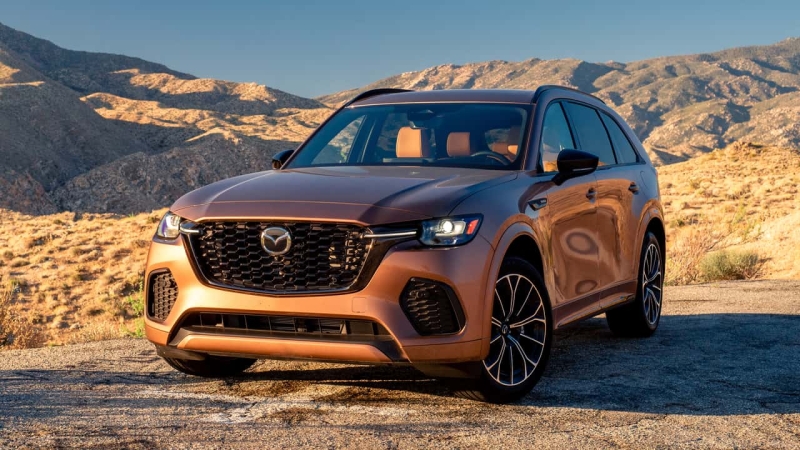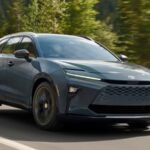The CX-70 is a fantastic driver’s SUV just like the CX-90… because it is a CX-90.
Mazda builds fun, engaging cars and that’s true even of its three-row SUV, the CX-90. The company’s newest two-row SUV delivers this same driving joy, as it should, because the CX-70 is the CX-90 with some trim bits changed and one fewer row of seats.
While I struggle to think of the reason I’d purchase a three-row SUV with just two rows, it doesn’t change the fact that the underlying package is undeniably engaging.
| Quick Specs | 2024 Mazda CX-70 Turbo S Premium Plus |
| Engine | Turbo 3.3-Liter I-6 |
| Output | 340 Horsepower / 369 Pound-Feet |
| Transmission | Eight-Speed Automatic |
| Base Price / As Tested | $41,900 / $57,855 |
| On-Sale Date | Now |
The underlying package is identical, too: The CX-70 gets the exact same drivetrain lineup as the CX-90. A 3.3-liter turbocharged straight-six with 280 horsepower comes standard, and a high-output 340 horsepower version is available on Turbo S models. Rounding out the lineup is a plug-in hybrid version with a 2.5-liter turbocharged inline-four supporting an electric motor with a 17.8 kilowatt-hour battery. All trims route power through an eight-speed automatic to all four wheels.
Cargo space, due to measuring quirks, actually shrinks slightly for the CX-70: 39.6 cubic feet versus 40.1 cubic feet behind the second row in the CX-90. When you’re stacking carry-ons, you’re unlikely to notice a difference. The CX-70 also gets a gaggle of underfloor hidden storage cubbies, as well, although they only add a small amount of total storage volume. Interior space is otherwise identical, with a roomy second row and excellent headroom in both rows.
Among the two-row mid-size class, the CX-70’s overall interior volume is above average, but then again, it’s a bigger SUV than average. Its 122.8-inch wheelbase is a foot longer than a Hyundai Santa Fe’s, and its 200.8-inch overall length is more than half a foot longer than the already-large Jeep Grand Cherokee. If you’re shopping for a two-row that’s easy to parallel park, look elsewhere.
The CX-70 insists on sporty driving dynamics, despite its mass. To play this up, the styling is more aggressive than the CX-90’s, with black trim and a less opulent grille design. The CX-70’s aesthetic is indeed a bit more aggressive—and I would argue even better looking—than the stunning CX-90.
The CX-70’s new, exclusive Molten Copper paint shade looked genuinely stunning set against the sand and skies of Palm Springs, CA. If you’re shopping based on looks alone, you can stop here. This is, for my money, the best-looking two-row SUV money can buy short of an Aston Martin DBX.
The only real non-aesthetic difference between the CX-70 and the CX-90 is that the base trim for the CX-70 is the Preferred. The CX-90 starts with a lower trim called the Select. This means that the eight-seat CX-90 ($39,300) starts at roughly a thousand dollars less than the five-seat CX-70 ($41,900), although trim-by-trim pricing otherwise is identical. The lack of a Select trim makes a confusing lineup even more vexing.
Put aside the confusion and get behind the wheel, and the CX-70—especially in Turbo S guise—is genuinely engaging to drive. I took a sunrise drive along Palms to Pines Highway to get acquainted with the two-row Mazda, and the desolate predawn pavement beckoned me to drive harder than I usually would in a crossover. The CX-70 is without a doubt one of the most enjoyable SUVs this side of a Porsche Cayenne that I could have driven up one of California’s finest hillclimbs.
Power comes on strong and throttle response is immediate. The eight-speed is decisive and paddle shifters, in sport mode, are reasonably responsive and hold gears aggressively. The steering—bolstered by front double-wishbones and a better-than-average weight balance—feels sharper than many modern sedans, with excellent weightiness and immediate feedback. The stiffer-than-average suspension keeps body roll and pitch to a minimum.
It’s not a cosseting ride, but it is rewarding. The plug-in-hybrid version doesn’t deliver power quite as aggressively, but its pedal feel and driving behavior is predictable enough that I still enjoyed my time in it. The Turbo S is indisputably where the CX-70 shines, though.
With a spirited drive behind me, I settled into mile-eating on I-10. There I found a deep appreciation for how luxurious the CX-70 feels inside. Fit and finish are superb—my Turbo S was optioned with Nappa leather and wood trim—and every touchpoint feels worthy of a vastly more expensive car. A handsome array of physical buttons for climate and a center knob for touchscreen control are pleasant to interact with, and although the infotainment system is simple, it’s sufficient. Amazon Alexa is also a new addition for the CX-70, in addition to wireless Android Auto and Apple CarPlay, for buyers who prefer a hands-off approach.
Less enjoyable was how that interior functioned, however. My large iPhone would not fit completely in the strangely designed and tiny wireless charger. Opening the sunroof was an unexpectedly deafening experience, as the wind deflector seemed to funnel wind and noise directly into the cabin. I couldn’t fit my smallest purse in the extremely shallow center console. Wireless CarPlay randomly disconnected in the middle of driving and wouldn’t function properly for the rest of the journey, even after cycling the Mazda on and off and trying various combinations of wires and Bluetooth.
Verging into the concerning department was a glitch in the CX-70’s blind-spot monitoring program. The CX-70 was convinced a car was constantly in my passenger-side blind spot on a perfectly sunny day without cars anywhere near me on I-10, and its insistence—and automated accident-avoidance steering-wheel jerk—were impossible to ignore.
All told, I was conflicted. The CX-70 offers the most fun of any vehicle in its segment, and its interior and tactile interface feels like it should cost tens of thousands of dollars more. I could see myself getting frustrated day-to-day with its imperfect tech, however, and a two-row version of a three-row-footprint SUV just doesn’t make much sense. If you hate chauffeuring your friends but must have 40 cubic feet of cargo space, I suppose the CX-70 makes sense; for everyone else, there are better choices, including Mazda’s own CX-90.
Competitors
- Honda Passport
- Hyundai Santa Fe
- Jeep Grand Cherokee
Gallery: 2025 Mazda CX-70 First Drive Review
2024 Mazda CX-70 Turbo S Premium Plus
Engine Turbocharged 3.3-Liter Straight-Six
Output 340 Horsepower / 369 Pound-Feet
Transmission Eight-Speed Automatic
Drive Type All-Wheel Drive
Speed 0-60 MPH 6.0 Seconds (est.)
Weight 4,863 Pounds
Efficiency 23 City / 28 Highway / 25 MPG Combined
Seating Capacity 5
Towing 5,000 Pounds
Cargo Volume 39.6 Cubic Feet / 75.3 Cubic Feet
Base Price $41,900
As-Tested Price $57,855
On Sale Now



